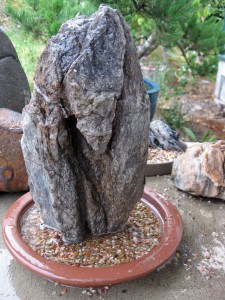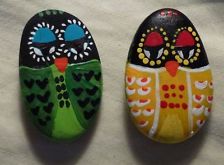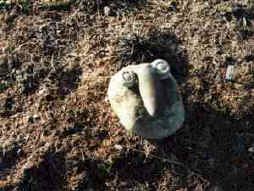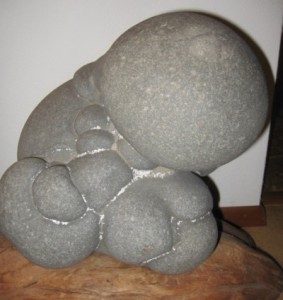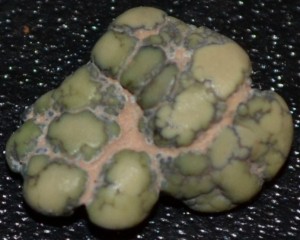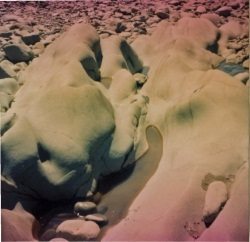Recently I volunteered for two children’s activities that involved rocks and beads. During a swarmed and overwhelmed session last week I had to assist in the creation of some 80 rock bug’s. The overwhelming choice being tasteless and garish choices in the material. Out of those 80 creations I found only a few that I felt comfortable with … some were simplistic as the next picture shows and others I doctored into color choices (some Native American) that I was comfortable with. Please note the many times I have used the word I.
True art reflects an appreciation between oneself and nature through metamorphic evolution. Rocks can have a magical presence and simply need to have the human eye recognize the hidden spiritual strength inside the rock before painting it over.
This returns me to the choices that kids or adults make in buying rocks, cabochons or rock based jewelry. Prejudices regarding color would be part of this. I for one
shy away from the bright and gaudy preferring earthen toned jasper’s and petrified wood.
That is our culture and the news media and the Internet provide link after link to pop culture and human icons that are clueless, brainless but in our culture worth being followed. The Bieber in his baggy pants. It is the same with actors. Some of my favorite actors were damn ugly. Well to be polite, they were homely: Richard Boon, ‘Have Gun will Travel” Hoss Cartwright, Jack Palance to name a few. Female actors might include Lilly Tomlin and Phyllis Diller.
I should create a blog about “rock your ugly.” Generally speaking rock shows under represent ugly rocks all the time. At our last local event, I neglected one vendor who was selling rare mineralogical specimens, spending my loot on the bright and shiny. I made up for that this year!
Agates or orbicular jasper always bring out the crow in me, the brightly colored, sparkly and pretty taking precedence over the dark obsidian or the more dully dark petrified wood.
The question to be asked is this; do we put aesthetic or monetary value on things because they are rarer? Not at all, some of these are actually quite common in nature, at least in the micro-mineralogical point of view.
Philosophically speaking if the earth were overpopulated with opal, diamond or sapphire, wouldn’t we be valuing the sedimentary mudstones instead?
The rest of us rocks, simply are like old folks, weathered, cracked and starting to return to that old folks home in the ground. Like humans, exposure to weather, UV, air, water and sunlight they become unattractive to those younger igneous creations. Love this Variscite!
Almost all the rocks you see at the surface are weathered, meaning that they’ve started to decay physically and chemically through exposure to air, water, sunlight, and erosive forces. Additionally, they’re probably smeared with a bunch of grimy black organic material from the topsoil. Example: unweathered pyrite vs. weathered pyrite vein in a rock (It basically turns to rust).
Are you sick of all the obsession with beauty? So am I. Pop culture is clueless. Ugly is awesome. You get genuine friends. You’re not looking in the mirror all the time. You spend time on smart things like developing your brain, talent, integrity & ability to help those who really need it.
Join our group and – “Rock Your Ugly”
Dealers of Ugly rocks often are under-represented in show reports, yet these are my favorite vendors.
Why are the vast majority of rocks and minerals dull and “ugly” while the rare ones are usually brightly colored, sparkly, or otherwise “pretty”?
Is this because we automatically place more aesthetic value on things that are rarer? Or is it just coincidence? If the majority of the planet were made of opal and diamond and gold and emeralds, etc., would we think the brown “ugly” rocks that were rare would be beautiful?
To put it another way, we tend to consider things that are colorful to be appealing. In geology, most rocks aren’t colorful. Why?
Because even schist can have gneiss cleavage. I have a feeling more bad puns are cummingtonite.

